#Daubenton's Myotis
Text
Extreme Quality Baby
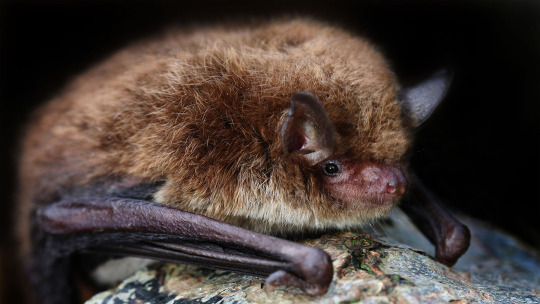
#Daubenton's Bat#Daubenton's Myotis#Bats of Eurasia#bats of Europe#Bats of Asia#they're everywhere#Bat#bats#batposting#cute bats#cute animals#you love to see them#I mean look at thi s#Absolute baby#The photo is so crisp too
202 notes
·
View notes
Text
youtube
How do Bats Hunt Their Prey?| Top Bat | BBC Earth
warning: flashing lights maybe?
#bat video#bat prey#water bat#Daubenton's bat#daubenton's myotis#Myotis daubentonii#brown long eared bat#Plecotus auritus#long eared bat#myotis#Youtube
24 notes
·
View notes
Text

Bonjour à tous !
Aujourd'hui je vous propose de découvrir la fiche du Murin de Daubenton ! ✨
C'est une espèce que l'on retrouve par exemple au-dessus des plans d'eau !
J'ai de beaux souvenirs associés à cette espèce : lorsque j'étais en stage dans les Vosges du Nord, j'ai pu l'observer plusieurs fois virevolter au-dessus de différents lacs l'été 🌄
Je pense que vous l'aurez compris au cours de ces différents posts, chaque saison est propice à une activité en lien avec les demoiselles de la nuit !
Durant l'été, on cherche à connaître les lieux où les femelles vont se regrouper en maternité pour élever leur unique petit de l'année (les mâles sont plus solitaires et dispersés). On se met donc à prospecter activement tous les lieux qui réunissent les critères préférés d'une espèce (combles pour certaines, sous les tuiles pour d'autres,...) Certains lieux sont parfois très atypiques, comme cette petite colonie de Murins de Daubenton qui avait décidé que leurs quartiers d'été seraient... sous une plaque d'égout ! 💦
Les chauves-souris savent toujours nous surprendre~
Je vous dit à demain pour la dernière petite fiche de cette série ! Si vous avez envie que j'aborde un sujet en particulier n'hésitez pas !🦇
#bats#chiroptera#clip studio paint#cute art#cute bats#drawing#i love bats#illustration#small artist#myotis#daubenton
1 note
·
View note
Text

Daubenton's bat (Myotis daubentonii)
By: J. L. Mason
From: The Complete Encyclopedia of the Animal World
1980
#daubenton's bat#microbat#bat#mammal#1980#1980s#J. L. Mason#The Complete Encyclopedia of the Animal World (1980)
48 notes
·
View notes
Note
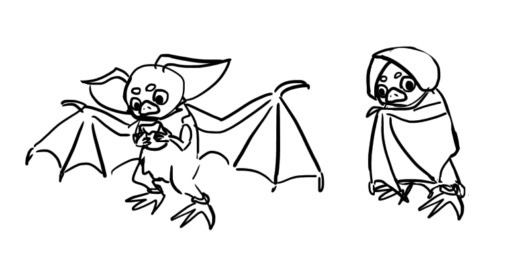
What… What kind of bat is Mimimi?
Omg i love her little hands and her "cloak" of herself!!! I love her little leaf/heart nose too, reminds me of a Woobat from Pokemon. <3
referencing my horrid little bat-fairy oc Mimimi.
My idea from her came from Vesper bats and "Myotis/mouse-eared bats", which are notoriously tiny, fiesty, and are everywhere. Where I'm from, a flock of them gets mistaken for sparrows like all the time.

Theres a species in my country called Daubenton's bat, which learned how to swim in response to constantly crashing into water when chasing bugs. Ingenuity at it's finest.

Due to there being over 120+ species of known Myotis bats, Mimimi just assumes every creature she encounters is another bat until told otherwise. XD
Mimimi: "What bat is you?"
Wukong: "I'm not a bat. I'm a monkey."
Mimimi: "Whats a monkey? You fly but you're not a bird nor bug, therefore Bat."
Wukong, realising he's on his cloud: "Hard to argue with that logic."
She also takes one look at Lady Earth Flow (aka the "Golden Nosed Albino Rat/Bat Spirit") and is like (´。• ◡ •。`) ♡ giant bat lady.
Zhu Bajie screams that they all get rabies shots.
19 notes
·
View notes
Note
sorry if you've talked about this before, but I'm curious if clanmew have different words for different bat species? they obviously differentiate insects and birds, but bat's are harder to distinguish at a glance. cats would have an advantage with their hearing, being able to hear bat's squeaks (and I think different species make different patterns and sounds?) but like. I don't remember how many bat species there are here (I think noctule, pipistrelle, greater horseshoe, lesser horseshoe, daubenton's, whiskered, barbastelle, and serotine? I mightve missed a couple), but I love bat's so thought I'd ask. pipistrelle are the most common though I'm from the south-east of England so I occasionally see daubenton's too.
FOUR bat species! Over here in the main entry for birds, check there if you'd like more trivia on them. Clan cats count them as very special, blessed songbirds.
The ones that Clan cats have words for so far;
Pipistrelle (Pipistrellus pipistrellus) = Popep
Soprano Pipistrelle (Pipistrellus pygmaeus) = Ipi'ip
Long-eared Brown Bat (Plecotus auritus) = Fepfr
Common Noctule (Nyctalus noctula) = Shi'po
There are four more kinds of bat, for EIGHT total in this region, that I have not yet described because I don't have good access to their song recordings (Even the main four were ass on butts to hunt down) If you have clear recordings of the songs of these four I'll add them too.
Pipistrellus nathusii
Nyctalus leisleri
Myotis daubentonii
Myotis nattereri
#Southeast England has more bat species#And more moth species funny enough#Because this region is a lot colder and further north#bats#And yeah Clan cats are better at distinguishing these because they are able to hear stuff we as humans can't#For example the Soprano Pipistrelle was only discovered pretty recently#But they've known about it for eons because its song is totally different
25 notes
·
View notes
Text
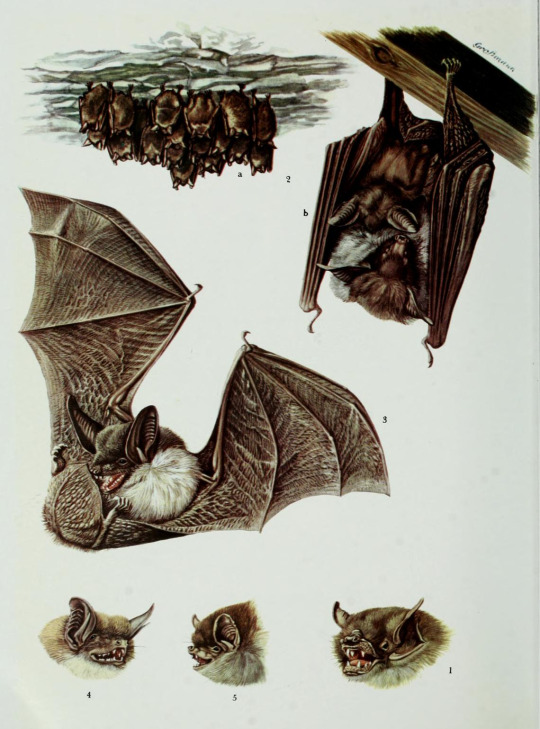
Grzimek's Animal Life Encyclopedia, vol. 11, Mammals II. 1972.
1.) Mexican funnel-eared bat (Natalus stramineus)
2.) Greater mouse-eared bat (Myotis myotis)
3.) Bechstein's bat (Myotis bechsteinii)
4.) Natterer's bat (Myotis nattereri)
5.) Daubenton's bat (Myotis daubentonii)
#bats#mexican funnel-eared bat#greater mouse-eared bat#bechstein's bat#natterer's bat#daubenton's bat
171 notes
·
View notes
Text
Myotis Bats
Myotis bats are much harder to tell apart visually and are substantially less common than Common or Soprano Pipistrelle.
Of the three species Daubenton's are the most commonly encountered, with Natterer's & Whiskered being fairly rare.
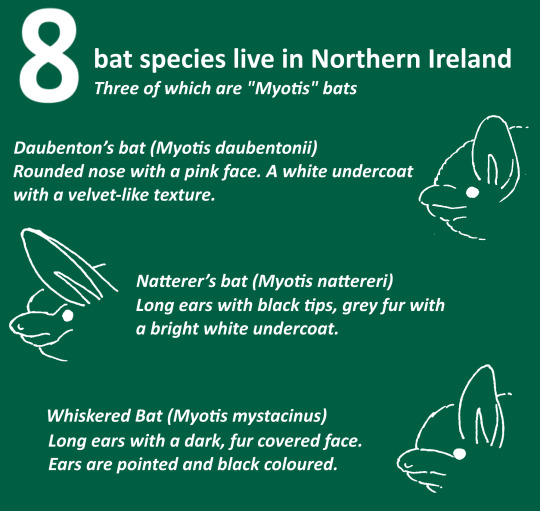
0 notes
Photo

Daubenton’s bat (Myotis daubentonii) capturing mealworm. Credit: Lasse Jakobsen SDU SCI-FRI: "Bats Use Death Metal ‘Growls’ To Make Social Calls" 1/20
0 notes
Text
Los murciélagos utilizan "gruñidos" como los del death metal para hacer llamadas sociales
Un vídeo de alta velocidad muestra cómo las membranas vocales y los pliegues ventriculares vibran a diferentes frecuencias.

Los murciélagos utilizan estructuras distintas en la laringe para producir llamadas de ecolocalización de alta frecuencia y llamadas sociales de menor frecuencia, según un estudio de Coen Elemans, de la Universidad del Sur de Dinamarca, y sus colegas, publicado el 29 de noviembre en la revista de acceso abierto PLOS Biology. Las estructuras utilizadas para realizar las llamadas de baja frecuencia son análogas a las utilizadas por los vocalistas de death metal en sus gruñidos.
Los murciélagos ecolocalizadores tienen un rango vocal extremadamente amplio, de 7 octavas, en comparación con las 3 ó 4 octavas de la mayoría de los mamíferos, incluidos los humanos. Sus llamadas de ecolocalización y sociales oscilan entre 1 y 120 kilohercios, lo que las hace únicas entre los mamíferos. Para entender cómo las diferentes estructuras vocales permiten a los murciélagos crear una gama tan amplia de llamadas, los investigadores extrajeron la laringe de cinco murciélagos de Daubenton (Myotis daubentonii) adultos, los montaron y filmaron a 250000 fotogramas por segundo mientras aplicaban un flujo de aire para imitar la vocalización natural. A continuación, utilizaron el aprendizaje automático para reconstruir el movimiento de las membranas vocales que estaban ocultas por otras estructuras.
Descubrieron que la presión del aire generaba vibraciones autosostenidas en la membrana vocal a frecuencias de entre 10 y 70 kilohercios, suficientes para producir llamadas de ecolocalización de alta frecuencia. En cambio, unos gruesos pliegues de la membrana situados justo encima de las cuerdas vocales, denominados "pliegues ventriculares", vibraban a frecuencias de entre 1 y 3 kilohercios, y es probable que participen en la producción de las llamadas sociales de baja frecuencia de los animales. Algunos seres humanos también utilizan sus pliegues ventriculares para producir vocalizaciones de baja frecuencia, como los gruñidos de death metal y el canto de garganta de los tuvanos.
El estudio es el primero en observar directamente las vibraciones autosostenidas en las estructuras vocales de los murciélagos que pueden generar la ecolocalización y las llamadas sociales. La selección natural para producir llamadas de alta frecuencia para la ecolocalización de presas y llamadas de frecuencia mucho más baja para la comunicación social han creado presiones evolutivas distintas que ampliaron el rango vocal de los murciélagos, dicen los autores.
Los autores añaden: "Demostramos que los murciélagos hacen vibrar membranas extremadamente finas y ligeras que se extienden desde sus pliegues vocales para realizar sus llamadas ultrasónicas de alta frecuencia para la ecolocalización. Para ampliar su limitado rango vocal inferior, los murciélagos hacen llamadas agresivas con sus pliegues ventriculares, como en los gruñidos de death metal".
Referencia:
Håkansson J, Mikkelsen C, Jakobsen L, Elemans CPH (2022) Bats expand their vocal range by recruiting different laryngeal structures for echolocation and social communication. PLoS Biol 20(11): e3001881. https://doi.org/10.1371/journal.pbio.3001881
0 notes
Text
As Blind as a Bat? Reflection and Perfection
As Blind as a Bat? Reflection and Perfection
I have cause for reflection as the bat project reaches a critical stage. Although I’ve shown the work in progress to a few trusted friends, I’m still not ready to break cover with all of the images. Partly because I set myself a technical and artistic standard that I’ve simply failed to achieve. It’s frustrating. But experience suggests that strategic patience could pay handsome dividends.
This…
View On WordPress
1 note
·
View note
Photo

Albino Daubenton’s Bat
Myotis daubentoni
Source: Here
904 notes
·
View notes
Text
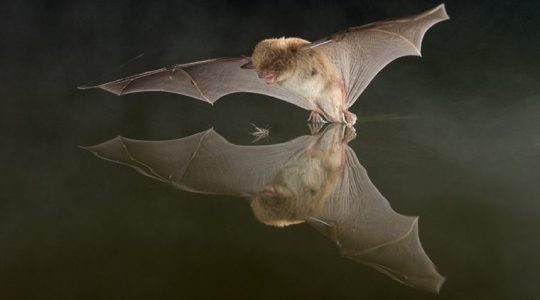
Daubenton's Bat (Myotis daubentonii)
Also known as the water bat, this species of bat hunts for insects near the surface of lakes, slow-moving rivers and canals.
image source: Paul van Hoof, via Bat Conservation Ireland
image description: a brown bat in flight so close to the water's surface that its feet appear to be touching the water as it approaches its prey
81 notes
·
View notes
Text


Bonsoir à tous~
Aujourd'hui je vous montre la carte et le sticker de Furina ! 🌊
Pour représenter Fontaine, j'ai bien évidemment choisi une espèce française inféodée aux milieux aquatiques ! Mon choix s'est donc porté sur le Myotis dasycneme aussi appelé Murin des marais !
Comme le Murin de Daubenton, elle chasse au ras de l'eau et fait de la jolie voltige, ce qui me semblait bien convenir à Furina ! 🦇
Pour son design, j'ai surtout conservé son chapeau, ses accessoires et son épée que je trouve très très cools ! ✨
Pour le décor je voulais vraiment garder le théâtre, même si il est avant tout suggéré car on le voit assez peu sur une si petite surface ! 🎭
J'espère que vous avez apprécié suivre cette petite série ! J'ai souhaité commencer avec les Archons mais j'ai vraiment envie de dessiner encore pleins de personnages et d'en faire une grande collection !
N'hésitez pas à me donner vos persos préférés, cela pourrait influencer mes futurs choix eheh~
Je vous souhaite à tous de belles fêtes de fin d'année et je vous remercie encore pour votre soutien cette année ❤️
#bats#chiroptera#clip studio paint#cute art#cute bats#drawing#i love bats#illustration#stickers#small artist#genshin impact#furina#archons
7 notes
·
View notes
Photo


A Watery Bat
Introducing the Water Bat, more commonly known as Daubenton's bat (Myotis daubentonii). These medium sized bats are commonly found in a strip ranging from Ireland to Japan, especially around bodies of water such as lakes and wetlands. This is because is almost exclusively hunts over water, where insects often gather. Using echolocation, they can find and catch tens of thousands of midges, caddisflies and mayflies in a single night, often increasing their bodyweight by half or more. In addition to their mouths, they can also use their feet and large tails to catch insects from the water’s surface. In the summer, the bats roost in trees and under bridges, where they raise their young in colonies. In the fall the bats mate, then hibernate over winter in underground caves, mines, and cellars and give birth in the spring.
The echolocation techniques of bats is unique and extremely accurate; using both the pitch and the intensity of the sound, they can interpret the distance and size of anything around them. The sounds they emit are so high pitched that humans can’t perceive them, and their clicks are so loud that, if we could hear them, they would sound as loud as a jet plane. The reason all bats, including the Daubenton’s bat, don’t go deaf is because they have a muscle attached to one of three bones in the middle ear that, when the bat emits a click, is pulled to disconnect the bone from the others. Bats can do this a hundred times a second, each time able to replace the bone in time to hear their clicks.
Conservation status: The Daubenton’s bat is protected in the UK and has a growing population, but is endangered in Germany and Austria. Status is unknown in Asia.
11 notes
·
View notes
Photo

🦇Bat Fact! Have you heard of Daubenton’s Bat (Myotis daubentonii)? The bat is an Eurasian Bat with short ears that can be found from Ireland to Japan, Portugal to Norway, and from China to Korea. Sometimes referred to as the “Water Bat”, this bat was first described in 1817 by Heinrich Kuhl. This bat is found to be 44-55mm long with an average weight of 7-15g and an average lifespan of 4-5 years, but has been recorded living up to 22 years! This bat can be found hunting in woodlands close to canals and rivers. This bat his insectivorous and will hunt non-biting midges and other midges, small flies, mayflies, and moths, all of which will usually be eaten during flight! When not hunting this bat will roost in caves, mines, tunnels, under bridges, and in cellars. Will rarely be found in bat boxes! This bat is listed as “Least Concern” by the IUCN🦇
📸Photo by Paul van Hoof(c)/BCI📸
#batfacts #bats #bat #akhyls #education
⬇️Follow Bat Facts⬇️
https://akhylsthebat.tumblr.com/
https://www.minds.com/akhylsthebat/
https://twitter.com/AkhylsBatFacts
https://t.me/AkhylsBatFacts
https://www.facebook.com/groups/137858924078846/
❗️Disclaimer: All images used here are for educational purposes and are not used in any way for profit or to promote any products or services. Copyright Disclaimer under section 107 of the Copyright Act 1976, allowance is made for “fair use” for purposes such as criticism, comment, news reporting, teaching, scholarship, education and research. Fair use is a use permitted by copyright statute that might otherwise be infringing❗️
1 note
·
View note